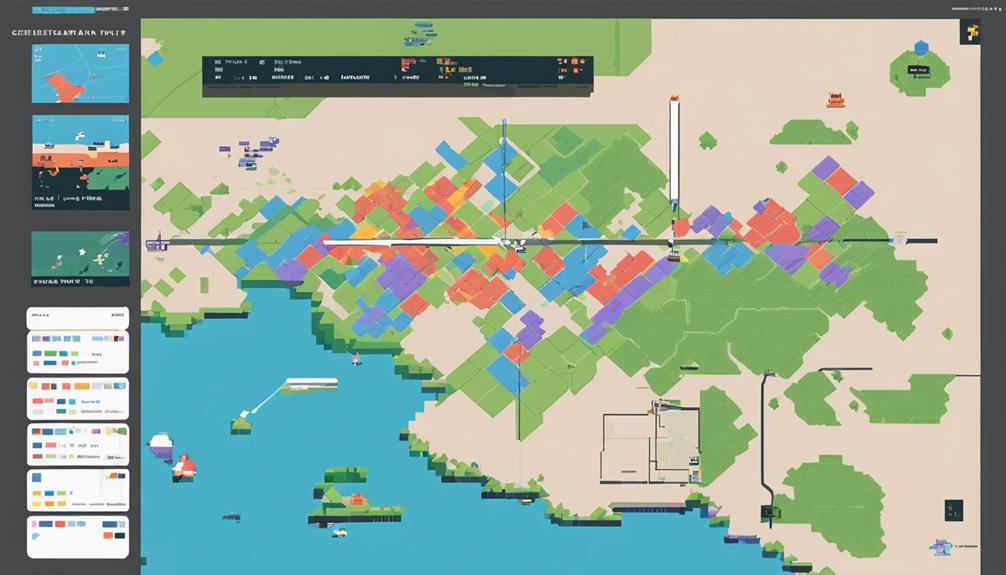In the fiercely competitive landscape of satellite internet providers, Starlink's rivals are orchestrating intricate market strategies to carve out their share of the market. As Amazon's Project Kuiper, OneWeb, Telesat, Iridium Communications, and AST & Science gear up to challenge Starlink's supremacy, a complex web of strategic moves is unfolding. From unique service offerings to targeted global expansion approaches, each contender brings a distinct flavor to the table, setting the stage for a battle of innovation and consumer-centric solutions. Amidst this strategic dance, the intrigue lies in dissecting how these players navigate the intricate market dynamics to gain a competitive edge.
Key Takeaways
- OneWeb focuses on enterprise partnerships and diverse service offerings.
- Telesat adopts targeted pricing and sector-specific solutions for competitiveness.
- SES SA's strength lies in its extensive network and high-performance broadband services.
- Viasat stands out with global presence, competitive pricing, and cutting-edge technology.
OneWeb's Competitive Market Strategies

In pursuit of capturing market share within the satellite network services industry, OneWeb has strategically positioned itself with a business-to-business model targeting enterprise customers and forging key partnerships with established telecom companies and ISPs. This approach allows OneWeb to leverage the expertise and existing customer base of these partners to extend its reach and offer a comprehensive suite of services.
OneWeb's focus on enterprise customers sets it apart in the market, catering to the specific needs of businesses for reliable and high-speed connectivity. By providing services such as cellular backhaul, emergency backup, and WiFi networks, OneWeb addresses critical requirements for businesses operating in diverse industries.
With plans to have 648 satellites in orbit for global service, OneWeb is on track to offer widespread coverage that can meet the demands of customers across the world. Currently operating 146 satellites, OneWeb has made significant progress towards its goal of delivering seamless connectivity on a global scale.
Furthermore, OneWeb's strategic partnerships with investors like Bharti Global and Hughes Network Systems demonstrate a strong commitment to expansion and innovation. These collaborations not only provide financial support but also open up opportunities for technology sharing and knowledge exchange, reinforcing OneWeb's position as a key player in the satellite network services industry.
Telesat's Approach to Satellite Internet Competition
Telesat's strategic approach to satellite internet competition involves a targeted pricing strategy aimed at businesses in need of high-speed connectivity. Additionally, Telesat's expansion plans focus on increasing coverage through the deployment of the Lightspeed constellation, enabling gigabit per second speeds and low latency for enhanced performance. By emphasizing tailored solutions for specific industry sectors and leveraging a combination of geostationary and LEO satellites, Telesat aims to establish itself as a leading provider of advanced satellite internet services.
Telesat's Pricing Strategy
With a strategic focus on catering to businesses, Telesat's pricing strategy for satellite internet services emphasizes competitive rates without compromising on quality or reliability. Telesat's upcoming Lightspeed constellation, consisting of 1,600 LEO satellites, is set to provide high-speed connectivity with gigabits per second speeds and low latency starting from early 2023. Additionally, the company currently operates 15 geostationary satellites to support its satellite internet services. Telesat's commitment to offering cost-effective yet high-quality services positions it as a strong competitor in the satellite internet market.
| Key Points | Details |
|---|---|
| Target Market | Emphasis on businesses |
| Satellite Constellation | Lightspeed with 1,600 LEO satellites launching in early 2023 |
| Current Satellite Fleet | 15 geostationary satellites in operation |
| Pricing Strategy | Competitive rates while ensuring quality and reliability |
Telesat's Coverage Expansion
Expanding its coverage through the deployment of the Lightspeed constellation comprising 1,600 LEO satellites, Telesat strategically positions itself to enhance its competitiveness in the satellite internet market focused on serving businesses. The Lightspeed constellation is designed to provide gigabit-per-second speeds and low latency, catering to the specific demands of enterprise customers. Telesat's emphasis on business clientele rather than consumers sets it apart in the satellite internet industry. With plans to launch the first Lightspeed satellites in early 2023, Telesat aims to further solidify its position as a key player in the market. Already operating 15 geostationary satellites, Telesat's strategic expansion through the Lightspeed constellation underscores its commitment to delivering high-performance satellite internet services to businesses.
EchoStar Mobile's Market Penetration Tactics

What strategies does EchoStar Mobile employ to penetrate the market with its mobile satellite services, leveraging its MSS and upcoming LEO satellite constellation for global IoT connectivity? EchoStar Mobile is strategically positioned in the market with its existing mobile satellite system (MSS) operated through the EchoStar XXI satellite. In addition to this, the company is actively developing an S-band constellation of low Earth orbit (LEO) satellites that will enhance its capabilities for providing global IoT connectivity.
EchoStar Mobile's dedication to innovation and excellence in the field is evident from its recent achievement of winning an IoT Business Impact Award in July 2023 for its groundbreaking solutions. This recognition underscores the company's commitment to advancing global IoT connectivity through cutting-edge satellite technology.
Telstra's Global Satellite Internet Strategy
EchoStar Mobile's innovative strides in the satellite market are exemplified through its strategic partnership with Telstra, Australia's leading telecommunications firm, showcasing Telstra's robust Global Satellite Internet Strategy. Telstra, known as Australia's largest telecommunications company, operates a vast network of over 60 satellites aimed at enhancing global connectivity. In a significant move in 2023, Telstra collaborated with SpaceX's Starlink to enhance rural internet access in Australia, showcasing its commitment to leveraging satellite technology for widespread internet availability.
Telstra's satellite strategy is laser-focused on expanding coverage and delivering reliable broadband services to users, especially in remote and underserved areas. This strategic approach involves seamlessly integrating the company's satellite network with its terrestrial infrastructure to provide uninterrupted connectivity. By aligning its satellite initiatives with the goal of bridging digital divides, Telstra is at the forefront of ensuring connectivity for all Australians, regardless of their geographic location.
With a strong emphasis on providing internet access through satellite technology, Telstra's Global Satellite Internet Strategy positions the company as a key player in the industry, dedicated to overcoming connectivity challenges and serving a diverse range of customers. Telstra's continued investment and innovation in satellite technology underscore its commitment to offering reliable and high-speed internet access to users across Australia and beyond.
SES SA's Competitive Edge in the Industry

SES SA's competitive edge in the satellite internet industry is underpinned by its established presence since 1985, operational network of over 160 O3b mPOWER terminals, and recent launch of two O3b mPOWER satellites in November 2023. This strong foundation enables SES SA to deliver high-performance broadband services, meeting the global connectivity demands effectively. Key factors contributing to SES SA's competitive advantage include:
- Innovative Network Services: SES SA's high-performance network services cater to global connectivity needs, ensuring seamless broadband services for diverse customers worldwide.
- Technological Advancements: The company's focus on innovation and technological advancements positions it as a leading provider of satellite-based solutions, meeting the evolving demands of the industry.
- Partnerships and Expansion: SES SA's strategic partnerships and continuous expansion efforts play a vital role in enhancing its market presence and growth trajectory in the satellite internet sector.
- Customer-Centric Approach: With a strong track record and customer-centric approach, SES SA stands out as a reliable and trusted provider of satellite-based solutions tailored to meet various connectivity requirements.
- Global Reach: SES SA's commitment to global connectivity further solidifies its position as a key player in the industry, offering reliable satellite services on a global scale.
Viasat's Market Expansion Initiatives
Viasat's market expansion initiatives are underpinned by its extensive global reach, encompassing a broad customer base across the U.S. and beyond. The company's competitive pricing strategy has been a key driver in attracting and retaining subscribers in a highly competitive market. Moreover, Viasat's continuous investments in satellite technology advancements, such as the upcoming Viasat-3 satellite, signify its commitment to providing cutting-edge broadband services to meet evolving consumer demands.
Viasat's Global Reach
With a focus on expanding its global market reach, Viasat is strategically positioning itself to capitalize on the demand for high-speed internet services through its upcoming ViaSat-3 GEO constellation launch in 2024. Viasat's current operations and future plans reflect its commitment to enhancing its presence in the satellite internet industry. Key points include:
- Operating at a higher orbit than SpaceX, serving approximately 590,000 U.S. subscribers in the previous year.
- Viasat-3 satellite set to offer download speeds of up to 100s of Mbps, meeting the need for high-speed internet access.
- Expressing concerns about orbital congestion due to SpaceX's Starlink mega-constellation in low-Earth orbit.
- Managing a fleet of four significant satellites: ViaSat-1, WildBlue1, Anik-F2, and ViaSat-2.
- The upcoming launch of ViaSat-3 GEO constellation in 2024 to expand global reach and service capabilities.
Competitive Pricing Strategy
Expanding its market foothold through a strategic competitive pricing strategy, Viasat aims to bolster its market expansion initiatives by offering broadband services tailored to meet the demands of approximately 590,000 U.S. subscribers. Viasat's approach includes providing internet deals starting at $25/month, catering to consumers seeking affordable high-speed internet solutions. Currently operating four large satellites, Viasat delivers broadband services with download speeds reaching hundreds of Mbps, ensuring a reliable connection for its customers. Furthermore, Viasat's upcoming satellite, Viasat-3, is poised to elevate market competitiveness by enhancing speed and capacity, solidifying its position in the satellite service industry. This commitment to market expansion initiatives underscores Viasat's dedication to offering quality services while remaining cost-effective and technologically advanced.
Satellite Technology Advancements
Utilizing cutting-edge satellite technology advancements, Viasat strategically positions itself for market expansion initiatives in the broadband services sector. Viasat operates in a higher orbit than SpaceX, serving approximately 590,000 U.S. subscribers. The company's focus on the Viasat-3 satellite aims to provide download speeds of up to hundreds of Mbps, enhancing services and facilitating market expansion. Viasat has expressed concerns about SpaceX's Starlink congesting low-Earth orbit, leading to operational efficiencies and the acquisition of Inmarsat for $7.1 billion. Additionally, Viasat plans to launch the ViaSat-3 GEO constellation in 2024, underscoring its commitment to innovation and technological advancements in the satellite technology realm. Viasat's market expansion strategies include job cuts for operational efficiency and the delivery of high-speed internet services through the ViaSat-3 GEO constellation.
Project Kuiper's Competitive Positioning
Project Kuiper's competitive positioning in the satellite-internet industry is bolstered by Amazon's substantial investment of over $10 billion and strategic partnerships with key space companies like Blue Origin. Amazon's ambitious Project Kuiper plans to deploy 3,236 satellites into orbit, directly challenging SpaceX's Starlink. This significant investment underscores Amazon's commitment to establishing a formidable presence in the satellite internet market, akin to the success it has seen with Amazon Web Services (AWS).
By collaborating with Blue Origin, Amazon is working towards the successful launch and operation of Project Kuiper's satellite constellation. These partnerships reflect Amazon's strategic approach to leverage expertise within the space industry to ensure the project's success. Amazon's CEO, Andy Jassy, envisions Project Kuiper as a major contender in the satellite internet sector, offering extensive coverage and high capacity services at competitive prices.
Through Project Kuiper, Amazon is poised to revolutionize the satellite-internet landscape, providing enhanced connectivity to underserved regions globally. With a focus on scalability, reliability, and innovation, Project Kuiper aims to deliver high-speed internet services that meet the evolving needs of consumers and businesses. Amazon's commitment to this venture signals its intent to become a leading player in the satellite internet industry.
Hughes Network Systems' Market Differentiation

Hughes Network Systems sets itself apart in the satellite internet market through its unique service features, competitive pricing strategies, and targeted customer segments. By offering a diverse range of broadband equipment and SDN-managed services, Hughes caters to a wide array of consumer needs. Its ability to supply over half of the global satellite terminal market underscores the company's strong position and expertise within the industry.
Hughes' Unique Service Features
With a strong focus on broadband equipment, SDN-managed services, and network operations, Hughes Network Systems distinguishes itself through its unique service features in the competitive market landscape. Hughes stands out through:
- Supplying over half of the global satellite terminal market.
- Being recognized as a Leader in Gartner's Magic Quadrant for Managed Network Services.
- Focusing on providing high-performance network services globally.
- Catering to a wide range of connectivity needs.
- Offering innovative solutions for broadband and network operations.
Hughes' commitment to cutting-edge technology and exceptional service quality solidifies its position as a top player in the satellite network industry, setting it apart from competitors.
Competitive Pricing Strategies
Market differentiation in the satellite internet industry is significantly influenced by Hughes Network Systems' implementation of competitive pricing strategies to attract a diverse customer base. Hughes Network Systems differentiates itself by offering cost-effective satellite internet options, aiming to capture market share through affordability. This emphasis on competitive pricing is a key component of Hughes Network Systems' overall strategy to stand out among rivals. By providing consumers with affordable broadband services, Hughes Network Systems attracts a wide range of customers, solidifying its position in the satellite internet market.
| Competitive Pricing Strategies |
|---|
| – Cost-effective solutions |
| – Attracting diverse customers |
| – Capturing market share |
| – Standing out among rivals |
| – Emphasis on affordability |
Targeted Customer Segments
Targeted customer segments play a pivotal role in the market differentiation strategy of Hughes Network Systems within the satellite internet industry. Hughes Network Systems targets a diverse customer base, including enterprise, government, and consumer sectors. The company's market differentiation lies in providing broadband equipment, network operation, and SDN-managed services. Hughes serves over half of the global satellite terminal market, showcasing its industry leadership. With a focus on innovation and technological advancements, Hughes offers high-performance network services globally. The company's strategic positioning allows it to cater to varied customer needs, from remote connectivity to large-scale network solutions.
- Diverse customer base including enterprise, government, and consumer sectors
- Broadband equipment, network operation, and SDN-managed services offered
- Industry leadership with over half of the global satellite terminal market
- Focus on innovation and technological advancements for high-performance network services
- Catering to varied customer needs from remote connectivity to large-scale network solutions
Inmarsat's Market Adaptation Strategies

Strategically positioning itself as a key player in the satellite industry, Inmarsat has implemented innovative market adaptation strategies aimed at enhancing its global network services. With a primary focus on delivering high-performance network services globally, Inmarsat has continually showcased its technological advancements. In 2023, the company successfully rolled out and tested over 160 O3b mPOWER terminals, demonstrating its commitment to staying at the forefront of the industry.
Notably, in November 2023, Inmarsat further bolstered its satellite network capabilities by launching two O3b mPOWER satellites. This move underlines the company's dedication to expanding and improving its services to meet the evolving demands of the market. Moreover, with the acquisition by Viasat for $7.1 billion in May 2023, Inmarsat aims to leverage unified assets to deliver enhanced products and services to its customers.
Inmarsat's expertise in operating 15 geostationary telecommunications satellites is a significant factor contributing to its strong market presence and offerings. By utilizing these satellites effectively, Inmarsat has been able to provide reliable and cutting-edge telecommunications services on a global scale, cementing its position as a leading player in the satellite industry.
Freedomsat's Market Niche Focus
Freedomsat's distinct focus lies in providing a comprehensive range of satellite, 4G, and fiber services tailored to meet the diverse connectivity needs of its customers. This strategic approach allows Freedomsat to cater to a wide range of users in the internet service market. Key points highlighting Freedomsat's market niche focus include:
- Service Variety: Freedomsat offers a wide array of connectivity options including satellite, 4G, and fiber services, ensuring that customers can choose the most suitable service based on their requirements.
- Affordable Deals: With internet deals starting as low as $25 per month, Freedomsat caters to various budget preferences, making quality internet access more accessible to a broader customer base.
- Expansion in Africa: Freedomsat has recently deployed new services on the Avanti Hylas 4 satellite, expanding its capacity in Africa and addressing the growing demand for reliable internet services in the region.
- Digital Divide Bridging: By focusing on affordable and reliable connectivity options, Freedomsat aims to bridge the digital divide, ensuring that both residential and commercial users have access to quality internet services.
- Targeted User Base: Freedomsat's services are designed to meet the needs of both residential customers looking for reliable home internet and commercial users requiring robust connectivity solutions, positioning the company strongly in the competitive internet service market.
Geespace's Competitive Market Tactics

Geespace employs a strategic focus on leveraging its satellite constellation project to enhance data transmission capabilities for Geely's autonomous driving program, showcasing a targeted approach in its competitive market tactics. The company, a subsidiary of Geely, has successfully launched nine satellites into low Earth orbit as part of its constellation project. This initiative underscores Geespace's commitment to providing robust data transmission services tailored to support Geely's innovative autonomous driving program.
With plans to expand its satellite constellation to 240 satellites, Geespace is poised to significantly enhance its data transmission capabilities. By concentrating on transmitting data for Geely's autonomous driving program, Geespace demonstrates a clear strategic market positioning that aligns with the increasing demand for reliable and high-speed data transmission services.
Moreover, Geespace's emphasis on building partnerships with other industries highlights its intent to broaden the reach and impact of its satellite services. This collaborative approach not only enhances Geespace's market competitiveness but also underscores its commitment to developing comprehensive solutions that cater to a diverse range of industries.
The alignment of Geespace's satellite initiatives with China's strategic goals for technological advancement further solidifies its position in the space industry. As China continues to assert its presence in space exploration and technology, Geespace's focused approach to data transmission services through its satellite constellation project positions it as a key player in the evolving landscape of satellite-based technologies.
The European Union's Satellite Internet Market Strategies
The European Union's strategic emphasis on developing its satellite internet capabilities as a competitive response to Starlink's market presence underscores a concerted effort to enhance high-speed internet access in underserved regions. The EU's satellite internet market strategies are multifaceted and aimed at leveraging satellite technology to bridge the digital divide. Key elements of the European Union's approach include:
- OneWeb Partnership: The EU has forged partnerships with companies like OneWeb, a major player in the satellite internet industry, to expand its satellite internet coverage and capacity.
- Telesat Collaboration: Telesat, another prominent European company, is working closely with the EU to enhance satellite internet services and infrastructure.
- Digital Agenda Alignment: The EU's focus on connectivity aligns with its digital agenda, which prioritizes economic growth and innovation through improved digital access.
- Investments in Infrastructure: Significant investments in satellite infrastructure are being made to strengthen the EU's satellite internet capabilities and competitiveness.
- Connectivity Drive: The European Union's satellite internet market strategies are underpinned by a drive to ensure seamless connectivity for all, especially in remote and rural areas where traditional internet infrastructure may be lacking.
Through these strategic initiatives, the European Union aims to not only compete with Starlink but also to drive socio-economic development through enhanced satellite internet access across the region.
Frequently Asked Questions
What Is the Business Strategy of Starlink?
In the vast landscape of digital connectivity, Starlink's business strategy resembles a meticulously crafted constellation, intertwining elements of business growth, global expansion, and technological innovation. With a laser focus on bridging the digital divide, Starlink leverages its fleet of satellites to provide high-speed internet access to underserved regions worldwide. By employing reusable rockets for efficient launches and targeting both residential and commercial markets, Starlink pioneers a path of connectivity with low latency and high reliability.
Who Is Starlink's Competitor?
SpaceX's Starlink faces competition from OneWeb, Amazon's Kuiper, and Telesat in the satellite internet industry. These companies aim to provide global broadband services, target enterprise customers, and utilize extensive satellite constellations. The competition in serving governments is heated, with Telesat, Lockheed Martin, and AST & Science also vying for market share alongside Starlink. Each competitor brings unique strengths and strategies to challenge Starlink's dominance in the industry.
What Is the Competitive Advantage of Starlink?
Starlink's competitive advantage stems from its cutting-edge technology innovation, notably its constellation of over 4,800 satellites providing global coverage. This infrastructure grants Starlink a significant edge in offering high-speed internet access with lower latency, setting a new standard in the satellite internet industry. With its efficient operations and superior user experience, Starlink has established itself as a dominant player, making it challenging for rivals to match its capabilities and reach.
Is Kuiper Competing With Starlink?
In the satellite-internet industry, Kuiper, Amazon's satellite project, aims to challenge Starlink by deploying its satellite technology to provide global coverage and high-speed internet access. Both entities face regulatory challenges and compete in customer acquisition. Kuiper's pricing models and future innovations suggest a keen interest in rivaling Starlink. The competition between Kuiper and Starlink fosters innovation and benefits consumers by enhancing services, affordability, and global connectivity options.
